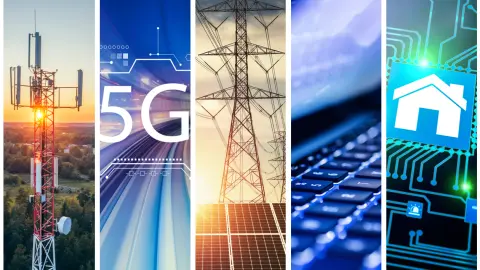2024 year of the smart home
The smart home will finally arrive in 2024. Today, there are many cheap microchips, excellent broadband and Wi-Fi networks, and many affordable smart home products. A new smart home standard, Matter, improves the ease of use while the desire to lower energy consumption is a killer application. Telecom operators could benefit through resell agreements
Introduction
Some 30 years after the 'House of the Future' was built in the South of the Netherlands - a project which employed smart systems and devices, including voice technology - we are finally ready to declare that mass adoption of the smart home is on the way. This is because a number of developments are finally coming together. The problem with the smart home and smart gadgets for some time now has been that the different devices, such as smart lamps, detection devices and cameras, did not work together, while the functionality of an integrated user interface was limited, also because the number of devices in houses was limited. Now, all of this is changing. There is a lot of (relatively) cheap gear, good user interfaces, and also a killer application to give customers the ability to better control energy use at home. Most importantly, there is also a new standard setting the scene: Matter, which greatly enhances the eco-system of smart home tools.
Cheap semiconductor sales are rising strongly
Let’s start by discussing the greatly improved availability of affordable smart home gadgets. Every device needs a microcontroller and a means to communicate. Any smart home device therefore has a small microprocessor system that is also capable of communicating by using, for example, a Wi-Fi or Bluetooth protocol. It is here where, over a decade ago, the ground was laid for the boom in smart devices. New products have been developed based on an ESP8266/ESP32 or ARM Cortex processor architecture. This architecture provided a cheap building block that became the foundation of many devices. As can be seen in the graph below, the number of ESP8266/ESP32-based systems that are cumulatively manufactured is expected to double in three years to two billion devices in 2026, up from nothing in 2013.
Stable networks are common today
At the same time, the quality of fixed network connections has improved, including enhanced indoor Wi-Fi through mesh networks. Reliable, high bandwidth networks are a condition for the acceptance of wireless control of domestic appliances because customers do not like the inability to connect to tools providing basic functionalities, such as controlling the room temperature or lighting systems. Moreover, the availability of high mobile data bandwidth gives customers the ability to see what’s on the cameras in their homes: functionality that is in demand as can be witnessed on the streets where camera-enabled doorbells are becoming ever more frequent. This is also why there is now a wide availability of cameras with large electronics retailers. The quantity of devices is not the only development that matters. The devices need to speak a language that is understood by the main dashboard. This challenge has also been resolved over a year ago, so that manufacturers have had time to develop innovative products, meeting the new standard.
Smart home semiconductor demand explodes
Espressif leads the IoT market with 1bn shipments of ESP8266/ESP32 platform

The new standard: Matter
For some time, large technology platforms included dashboards and control panels for the smart home in their software. Examples include Apple’s Home Kit, Amazon’s Alexa, Google Home, but also the Philips Hue system and Home Assistant, an open-source project with global reach. There were also many companies offering products for the smart home, such as smart lighting solutions from Signify, smart plugs, doorbells, cameras, home audio and smart domestic appliances. Also, Ikea has a wide range of products for the smart home. The interoperability has been greatly improved because of the new standard, Matter. This new standard was designed to enhance the compatibility and interoperability of devices from different vendors. Matter has been developed by the Connectivity Standards Alliance. Members of the alliance are, for example, Apple, Amazon, Google, as well as Ikea, Schneider, Huawei, Signify, NXP, Infineon, ST Microelectronics, Tuya, Samsung, Resideo and Verizon. Truly an industry-wide group. Devices that are designed according to the Matter standard are interoperable across multiple platforms, removing barriers between multiple ecosystems.
IDC's Worldwide Smart Home Device Forecast by Shipment Volume
Expected shipments in millions
Shipment volume as expected by IDC underestimates demand for smart home products
We are not alone in expecting strong growth in the market. IDC expects that the market for smart home devices will expand by 6% annually from 2023-2027. Product categories that show above-average growth rates are Home Monitoring (7.1%) and Lighting (13.6%). Nevertheless, we think the figures underestimate the growth in shipments, as the expectations on the expected increase in shipments show, above. If the shipments on the ESP8266/ESP32 platform show, these shipments double until 2026. These microchips are not only used for smart home products. Nevertheless, we think the growth rate of these products is more indicative of the increase in shipments of smart home tools.
Need for energy preservation could be a catalyst
Apart from user friendliness and affordable prices, many citizens are currently concerned with their environmental footprint and their energy use at home. Smart tools offer a great way to monitor one’s energy consumption while giving greater control over domestic lighting and heating. This is especially relevant with fluctuating energy prices. Notably, some consumers in the Netherlands are looking to profit from negative electricity prices, using machines that use a lot of energy when prices are negative. Smart home applications can therefore fulfil an important customer need today, beyond the ability to switch devices on and off remotely. Data from a report by Park Associates (on behalf of Resideo) shows that 16% of Americans (with broadband) have a smart thermostat.
Smart homes need to be safe
Besides the need for a great user experience, one likely obstacle to the broad adoption of smart products has probably been safety. Lately, there have been many news stories about insecure devices hosting botnets. Also, devices that use remote cloud server providers host data outside the home. The Matter standard is focused on enhanced security and local control as is the Home Assistant platform. Apple also has a strict requirement in place for products that want the "Works with Apple Home" badge. Nevertheless, we believe there is scope for a consumer service focused on the secure maintenance of a (separate) in-house network.
Can telecom operators benefit from the opportunities the smart home offers?
What’s in it for telecom providers? The smart home is a natural extension of the traditional services of telecom operators: secure communication and often the provision of a media box. So far, some telecom providers are giving advice to customers on the optimal use of indoor Wi-Fi. They sometimes also offer software packages to enhance network safety and sell mobile handheld devices. Now that smart home platforms and smart products look stable and relatively easy to install, we think telecom providers could become resellers of secure smart home devices and possibly services, such as the provision of a smart hub at home, or trusted cloud access. KPN is doing this already, today. In doing so, happy customers are less likely to go to a competitor. Given that churn reduction is the holy grail for the telecom industry, exploring the option of selling innovative services is worth a try.
Download
Download article
1 February 2024
Telecoms Outlook 2024: Stepping into the future This bundle contains {bundle_entries}{/bundle_entries} articlesThis publication has been prepared by ING solely for information purposes irrespective of a particular user's means, financial situation or investment objectives. The information does not constitute investment recommendation, and nor is it investment, legal or tax advice or an offer or solicitation to purchase or sell any financial instrument. Read more

